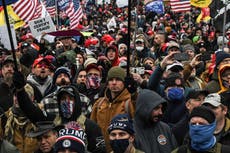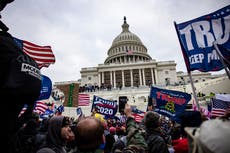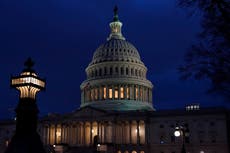We all deserve better than comparing the riots at the US Capitol to events in the Middle East
It is easy to see how people grope for quick and emotive comparisons, but that is not the best option

It was bound to happen. As soon as crowds stormed the seat of the US government and the first tear gas cannister was fired, the sweeping comparisons to an amorphous Middle East or North Africa conflict came flooding in.
"I'm not in Baghdad. I'm not in Kabul. I'm not in a dangerous situation overseas. We are in America,” said Martha Raddatz, ABC’s chief global Affairs correspondent, visibly shaken.
"Where we're headed looks more like Syria than the United States of America,” said CNN host Van Jones, from the studio.
Chris Hayes, an MSNBC anchor, even tweeted that the pro-Trump mob attack on the Capitol had a higher death toll than 2012 militant attack in Benghazi during which four Americans, including the US ambassador, were killed.
It sparked a slew of tweets from people saying that the storming of the Capitol was worse than Libya.
There is no doubt that Wednesday’s events – during which five people, including a police officer, were killed – were shocking and galling. The full extent of the danger faced by elected officials, police officers and journalists is only being computed now as fresh video footage and testimonies come in.
And so vague comparisons to deeply complex conflicts, civil wars and uprisings in the so-called third world are not only laughably wrong but dangerous for America’s future.
Enough Twitter ink has been spilled over why the storming of the Capitol, after encouragement from president Donald Trump, is not like Baghdad or Syria and why saying that it is, is actually insulting (and potentially racist) given the involvement of the US in – and so responsibility for – some conflicts in the Middle East region.
Many have also pointed out that it belittles the level of violence people would be subjected to by authoritarian regimes. Believe me, the outcome would have been very different if, say in Egypt, mobs had donned bulletproof hats and vests, weapons and zip ties and attempted to storm the parliament.
But the key issue is that these wishy-washy comparisons distract from the very real truth here: that this isn’t the US morphing into some nebulous foreign war zone; this is America suffering from a severe and worrying case of America. The only way to handle this and heal these wounds is to face that ugly reality and tackle it.
Comparing this to the “Middle East” perpetuates the myth that the people who stormed the Capitol aren’t extreme representatives of angry segments of US society.
It also perpetuates an unhelpful brand of American exceptionalism which has long been dismissed abroad. It allows commentators to sensationalise and “other-ise” what happened that afternoon in their own capital. They are essentially saying that this isn’t our exceptional America, this is somewhere else.
As crazy as some of the perpetrators may have looked in their Viking hats and fur pelts, the flags, signs and symbols some were wielding are extremely concerning and American.
Among the groups the Anti-Defamation League has identified as being present from their banners were a few anti-government American militia movements – including the Three Percenters, Guardians of the Republic and the Oath Keepers – that, according to the ADL, try to recruit members from among serving or retired US soldiers and police officers. There were also American far-right groups.
Those attending also included a man wearing a “Camp Auschwitz” hoodie, and people with stickers of the so-called Nationalist Social Club that has regional chapters across the country.
Other flags and symbols are directly related to Trump, such as the “MAGA civil war” shirts some were wearing – which cites his first campaign slogan – and “Release the Kraken” flag which, according to CNN, references former Trump lawyer Sidney Powell’s comments that she falsely had evidence that could prove Joe Biden didn’t win the election.
One of the most infamous images taken, that can only be grounded in US history, was a man waving the Confederate battle flag, a symbol of support for slavery, which during the US’s civil war had never come within the walls of the US Capitol.
Even the individuals themselves could hint at the start of a very American story.
Among those who were identified breaking into the Capitol – clad in combat helmets, body armour and other tactical gear – was a retired and decorated US Air Force combat veteran, according to John Scott-Railton, a senior researcher at Citizen Lab at the University of Toronto. The man later confirmed he had been in the Capitol that day.
Also present was a newly-elected West Virginia state Republican official who live-streamed himself entering the Capitol with the mob and has since resigned after being arrested.
There is no need to belabour the point. Faced by such horror, it is easy to see how people grope for quick and emotive comparisons.
But this has happened for too long, and without identifying and grappling with the very American roots of this problem, the violence will only continue.



Join our commenting forum
Join thought-provoking conversations, follow other Independent readers and see their replies
Comments